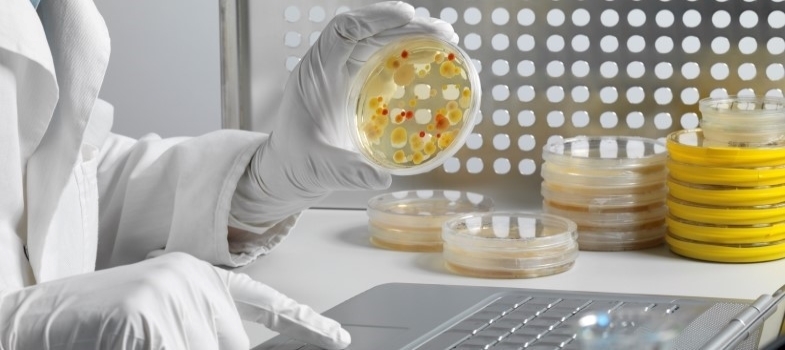5.5 Steps involved in sampling for AMR
As an overview, the following steps should be considered when sampling livestock or aquaculture species for AMR.
- Decide on the source of your sample animals: In most cases, this will be slaughterhouses, but it could also be farms or the market/point of sale.
- Identify the target bacterial species: This might be commensal bacteria or zoonotic bacteria species.
- Outline a sampling frame: This might be a list of all the farms or ponds in the target population, or all the slaughterhouses. Remember that it is ideal to have at least 80% of the total target population listed in the sampling frame, although this can be difficult to achieve.
- Determine a sampling strategy, including how to select sampling units: Consider using probability sampling methods.
- Calculate the required sample size: This may require more than one calculation (such as the number of farms and then number of animals on each farm), and may require adjustment in light of non-statistical determinants of sample size. Be sure to consider whether you need to adjust the number of animal specimens to sample if the target bacterial species are not expected to be isolated from all samples.
Activity 9: Planning your own sampling
Think of a target population of interest to you in your role, or in your country more generally. You might want to use the same example you considered in Activity 2. Think about an important research or surveillance question and use the space below to reflect on the steps for planning sampling:
- What are the possible sources of samples? Are there options at slaughterhouses, farms and retail outlets? Which sampling site do you think would be most effective, and why?
- Identify your target bacterial species. For your example, is it of more interest to focus on commensal or zoonotic bacteria in your population?
- Identify a possible sampling frame, and the source of information for this sampling frame.
- What type of sampling method would you use? Are there advantages to using multistage sampling compared to simple random sampling?
- What considerations might you need to take into account when preparing a sample size calculation? Do you expect the target bacteria to be present in all the animal samples collected? Do you need to take dropout or clustering into account?
Discussion
How did you get on with this activity?
If you used the fish farm example from Activity 2, you may have considered the following steps:
- Sample sources include fish farms, fish slaughterhouses, wet markets or retail outlets. As testing for AMR in aquaculture often happens in the context of an outbreak investigation, it is common to collect samples of diseased fish at farms. In aquaculture, many farmed fish are slaughtered in processing units at the farm, or sold live to consumers who kill the fish at home, so fish slaughterhouses are not a representative sample source. Sampling at wet markets and retail outlets may be feasible, but it is difficult to capture data on AMU when sampling away from farms.
- Target bacterial species in fish might include Vibrio parahaemolyticus or Listeria monocytogenes, which infect a wide range of farmed fish and shellfish, and can cause severe disease in humans. These are two of the species OIE recommends for surveillance of AMR in aquaculture (see Table 1).
- A sampling frame of fish farms might be obtained by requesting access to the official registry of fish farms maintain by the Ministry of Fisheries or equivalent. A sampling frame of retail outlets might be more difficult to obtain, especially as there are likely to be informal market sellers as well as large outlets.
- A multistage sampling strategy is appropriate, where geographical areas such as districts are first selected, and then farms within the district are randomly selected. If you are interested in sampling more than one commodity species (such as tilapia and catfish), you might consider a stratified multistage sample to ensure adequate representation of each commodity species.
- The target bacteria cause disease in fish as well as humans, so are unlikely to be present in every collected sample. The sample size will need to be adjusted accordingly. Because most fish farms consist of one or more ponds, the specified number of samples should be collected evenly from each pond, rather than all samples from one pond. Either way, this additional level of clustering will need to be taken into account at design and analysis stages.
5.4 Samples versus isolates



